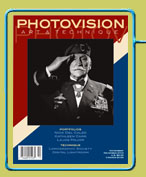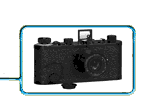![]()
Book Reviews

Although the photogram has been around since the beginning of photography, its abstract aesthetic has often been overlooked by viewers conditioned to appreciate only representational uses of the medium. Worse, its visual potential has been and remains woefully underutilized by photographers.
Part of the problem may be that photo historians and critics have overwhelmingly written about the photogram in terms of Man Ray and Laszlo Moholy-Nagy's contributions, at the expense of more radical (and arguably more profound) photogram practioners like Arthur Siegel, Thomas Barrow and Michael Spano. As a result, many would-be camera-less image makers take a reductive approach to this process, too often producing nothing more than trite Man Ray imitations.
The photograms of Adam Fuss stand in diametric opposition to this lifeless dynamic. Since the late 1980s the British artist has been creating a body of work that continually expands the parameters of the photogram in terms of content, technique and emotional intensity. His images celebrate the mysterious and mystical properties inherent in mundane organic matter, creating a fusion of the abstract and the specific in strange and satisfying ways. They are completely unlike any photograms ever done.
Much of their originality lies in Fuss' sometimes controversial choice of subject matter. At various times he has used dead birds, cow livers, rabbit entrails, even sperm, carefully arranged on large sheets of Cibachrome. Flash exposure is used to burn the silhouettes onto the emulsion of the paper, which is then developed normally.
Perhaps the most remarkable photograms are those made with the intestines of small rabbits. As the animal's fluids interact with the Cibachrome paper and the chemical developer, strange and unpredictable color reactions take place, resulting in bizarre hues that vibrate with a profound, if unsettling beauty. (The cow livers also produce this intense riot of color.) While these images succeed on one level as powerful abstract statements, their visceral quality resonates with a kind of leftover spiritual energy from the deceased animal.
Some may be turned off by this particular subject matter, but it's germane to the artist's obsession with what he feels are the mystical properties inherent in all matter – animal, vegetable and mineral. Fuss' photograms are also informed with a sense of the connectedness of all living things, no matter how humble.
Fuss achieves a similar effect using flowers, mushrooms and plant roots; the movement of small snakes across paper covered with powder or immersed in water; stained glass; and other disparate elements that Fuss links organically through a combination of darkroom alchemy and graphic consistency.
Arena Editions' beautiful reprint of this eponymous volume (which first appeared in 1997) offers a fresh opportunity for those interested in the photogram to become acquainted with one of its modern masters. DB

| Adam Fuss Arena Editions, $65 (ISBN 0-9657280-1-3) 
|
Although the photogram has been around since the beginning of photography, its abstract aesthetic has often been overlooked by viewers conditioned to appreciate only representational uses of the medium. Worse, its visual potential has been and remains woefully underutilized by photographers.
Part of the problem may be that photo historians and critics have overwhelmingly written about the photogram in terms of Man Ray and Laszlo Moholy-Nagy's contributions, at the expense of more radical (and arguably more profound) photogram practioners like Arthur Siegel, Thomas Barrow and Michael Spano. As a result, many would-be camera-less image makers take a reductive approach to this process, too often producing nothing more than trite Man Ray imitations.
The photograms of Adam Fuss stand in diametric opposition to this lifeless dynamic. Since the late 1980s the British artist has been creating a body of work that continually expands the parameters of the photogram in terms of content, technique and emotional intensity. His images celebrate the mysterious and mystical properties inherent in mundane organic matter, creating a fusion of the abstract and the specific in strange and satisfying ways. They are completely unlike any photograms ever done.
Much of their originality lies in Fuss' sometimes controversial choice of subject matter. At various times he has used dead birds, cow livers, rabbit entrails, even sperm, carefully arranged on large sheets of Cibachrome. Flash exposure is used to burn the silhouettes onto the emulsion of the paper, which is then developed normally.
Perhaps the most remarkable photograms are those made with the intestines of small rabbits. As the animal's fluids interact with the Cibachrome paper and the chemical developer, strange and unpredictable color reactions take place, resulting in bizarre hues that vibrate with a profound, if unsettling beauty. (The cow livers also produce this intense riot of color.) While these images succeed on one level as powerful abstract statements, their visceral quality resonates with a kind of leftover spiritual energy from the deceased animal.
Some may be turned off by this particular subject matter, but it's germane to the artist's obsession with what he feels are the mystical properties inherent in all matter – animal, vegetable and mineral. Fuss' photograms are also informed with a sense of the connectedness of all living things, no matter how humble.
Fuss achieves a similar effect using flowers, mushrooms and plant roots; the movement of small snakes across paper covered with powder or immersed in water; stained glass; and other disparate elements that Fuss links organically through a combination of darkroom alchemy and graphic consistency.
Arena Editions' beautiful reprint of this eponymous volume (which first appeared in 1997) offers a fresh opportunity for those interested in the photogram to become acquainted with one of its modern masters. DB


